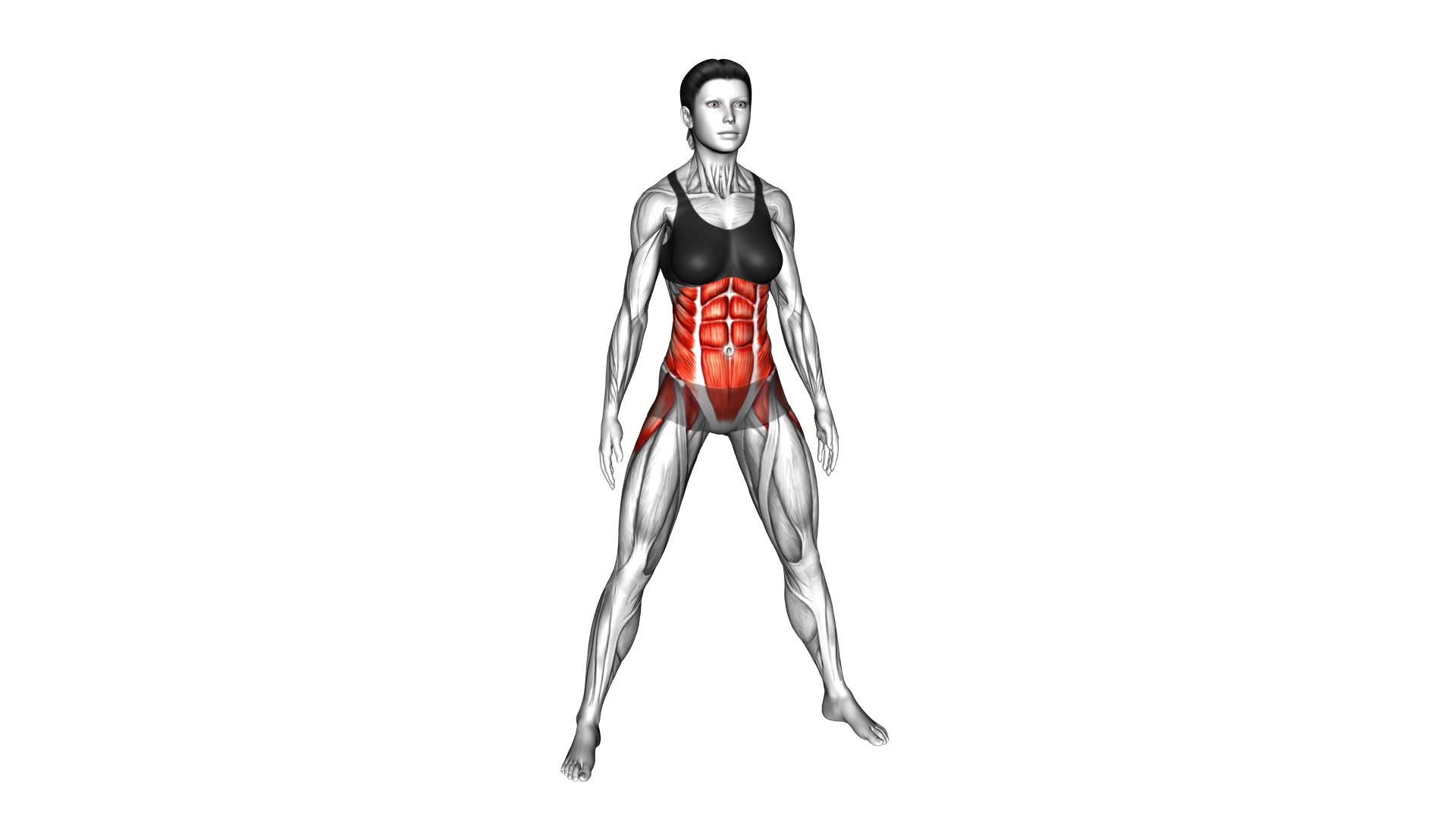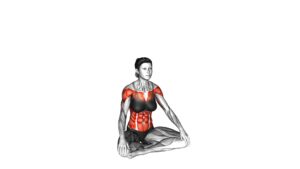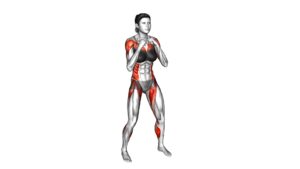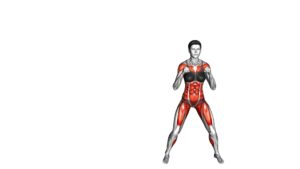Diagonal Bend Hold (female) – Video Exercise Guide & Tips

Are you looking for a challenging exercise that targets your core and improves your flexibility? Look no further than the Diagonal Bend Hold!
Watch This Exercise Video
In this video exercise guide, you'll learn the proper form and technique for performing this exercise, along with variations and progressions to keep you motivated.
Avoid common mistakes and maximize your results by following our expert tips.
Get ready to strengthen and tone your body with the Diagonal Bend Hold!
Key Takeaways
- The Diagonal Bend Hold targets core muscles, including obliques, abdominals, and lower back.
- It strengthens and tones core muscles, leading to improved stability and balance.
- Engaging glutes, hips, and shoulders improves overall muscle coordination.
- The exercise enhances functional strength, posture, flexibility, and athletic performance, while reducing the risk of injuries.
Benefits of the Diagonal Bend Hold
You can experience numerous benefits from incorporating the diagonal bend hold into your exercise routine. This exercise primarily targets your core muscles, including your obliques, abdominals, and lower back. By consistently practicing the diagonal bend hold with proper form, you can strengthen and tone these muscles, leading to improved stability and balance in your daily activities.
In addition to core strength, the diagonal bend hold also engages your glutes, hips, and shoulders. This full-body engagement helps to improve overall muscle coordination and enhances your functional strength. By incorporating this exercise into your routine, you can also improve your posture, as it requires you to maintain a straight back and neutral spine position throughout.
Another benefit of the diagonal bend hold is its ability to increase your flexibility. This exercise requires you to stretch your muscles and joints, particularly in the hips and shoulders, as you rotate your body. Regular practice can help you develop greater range of motion in these areas, allowing for improved athletic performance and reduced risk of injuries.
To ensure proper form while performing the diagonal bend hold, start by standing with your feet shoulder-width apart, knees slightly bent. Keep your back straight, engage your core, and slowly lean to one side, reaching your hand towards your knee. Hold this position for a few seconds before returning to the starting position and repeating on the other side.
Incorporating the diagonal bend hold into your exercise routine can provide you with various benefits, including improved core strength, enhanced muscle coordination, increased flexibility, and better posture. Remember to always prioritize proper form to maximize the effectiveness and safety of this exercise.
Proper Form and Technique
When performing the Diagonal Bend Hold, it's important to maintain proper body alignment throughout the exercise. This means keeping your core engaged, shoulders back, and spine in a neutral position. By doing so, you can maximize the effectiveness of the exercise and minimize the risk of injury.
Additionally, it's crucial to avoid common form mistakes such as rounding your back or allowing your hips to sag.
Body Alignment During Exercise
During your exercise routine, it's crucial to maintain proper body alignment throughout the movements. Proper body alignment ensures that you're using the correct muscles and minimizing the risk of injury.
One important aspect of body alignment is core engagement. Engaging your core muscles, such as the abdominals and lower back, helps to stabilize your spine and maintain a neutral position. This not only improves your overall posture but also enhances the effectiveness of the exercise.
Additionally, proper breathing technique plays a significant role in maintaining body alignment. Taking deep breaths and exhaling during exertion helps to stabilize your core and improve your overall body control.
Avoiding Common Form Mistakes
Maintaining proper body alignment is crucial for avoiding common form mistakes and ensuring proper form and technique during the Diagonal Bend Hold exercise. To maximize your results and prevent injury, keep the following tips in mind:
- Engage your core muscles throughout the exercise to stabilize your body and maintain proper alignment.
- Avoid rounding or arching your back, as this can strain your spine. Keep your back straight and neutral.
- Keep your shoulders relaxed and away from your ears. Avoid shrugging or hunching forward.
- Maintain a steady and controlled breathing pattern to enhance your stability and focus.
- Pay attention to your hip placement. Avoid letting your hips sag or rotate, as this can put stress on your lower back.
Variations and Progressions
Now let's explore advanced progression options and the benefits of variations for the diagonal bend hold exercise.
By incorporating advanced progressions, you can challenge your body further and continue to make gains in strength and stability.
Variations of the exercise can target different muscle groups or increase the difficulty level, allowing you to continually challenge yourself and avoid plateaus.
These variations and progressions can help you take your diagonal bend hold to the next level and maximize its effectiveness in your workout routine.
Advanced Progression Options
To advance your abilities in the Diagonal Bend Hold exercise, incorporate challenging variations and progressions. Here are five advanced progression options to take your workout to the next level:
- Weighted Diagonal Bend Hold: Hold a dumbbell or kettlebell in your top hand while performing the exercise to increase resistance and challenge your muscles further.
- One-Legged Diagonal Bend Hold: Lift one leg off the ground and hold it in the air while performing the exercise. This variation adds instability and engages your core and leg muscles more intensely.
- Elevated Diagonal Bend Hold: Place your bottom hand on an elevated surface, such as a bench or step, to increase the range of motion and target your obliques and shoulders more effectively.
- Resistance Band Diagonal Bend Hold: Attach a resistance band to a sturdy anchor point and hold onto the band with your top hand. The band adds continuous tension, making the exercise more challenging.
- Reverse Diagonal Bend Hold: Perform the exercise in the opposite direction, with your top hand reaching towards your bottom leg. This variation targets different muscles and adds variety to your workout.
Incorporating these advanced modifications and incorporating equipment will help you push your limits and achieve greater strength and stability in the Diagonal Bend Hold exercise.
Benefits of Variations
By incorporating variations and progressions, you can maximize the benefits of the Diagonal Bend Hold exercise and challenge your muscles in new and effective ways.
Modifications to this exercise can provide a range of benefits, such as targeting specific muscle groups or increasing the intensity of the workout. For example, you can try using a resistance band or adding weights to your hands to increase the resistance and strengthen your muscles even further.
Additionally, variations like the Side Plank with Leg Lift or the Diagonal Bend Hold with Knee Tuck can help engage different muscle groups and improve overall core stability.
However, it's important to remember the importance of proper technique when performing these variations to avoid injury and ensure optimal results.
Common Mistakes to Avoid
To prevent common mistakes and maximize your results, it's important to be aware of the following errors to avoid when performing the Diagonal Bend Hold exercise:
- Improper alignment: Make sure to keep your body in a straight line from head to toe. Avoid sagging or arching your back.
- Lack of core engagement: Engage your core muscles by pulling your belly button towards your spine. This will help stabilize your body and prevent strain on your lower back.
- Holding your breath: Remember to breathe throughout the exercise. Holding your breath can increase tension in your muscles and make the exercise less effective.
- Using momentum: Avoid swinging your body or using momentum to lift your leg. Instead, focus on controlled movements and use your muscles to lift and hold the position.
- Neglecting proper form: Pay attention to your form and technique. Keep your shoulders down and relaxed, and maintain a neutral neck position. This will help prevent unnecessary strain on your upper body.
By avoiding these common mistakes and focusing on proper technique, you can ensure that you get the most out of the Diagonal Bend Hold exercise. Remember to start with a weight that challenges you but still allows you to maintain good form.
With consistent practice and attention to detail, you'll be on your way to achieving your fitness goals.
Tips for Maximizing Results
To maximize your results, it's important that you incorporate these tips into your Diagonal Bend Hold exercise routine.
One way to increase the intensity of the exercise is to hold the position for a longer duration. Start by aiming for 30 seconds and gradually work your way up to a minute or more. This will challenge your muscles and help you build strength and endurance.
Another tip for maximizing results is to focus on proper form and technique. Make sure your body is properly aligned throughout the exercise, with your core engaged and your back straight. This will ensure that you're targeting the right muscles and avoiding any unnecessary strain or injury.
To further increase the resistance and intensity of the Diagonal Bend Hold, you can try using ankle weights or resistance bands. These tools will add extra resistance and make the exercise more challenging. Start with lighter weights or bands and gradually increase the resistance as you get stronger.
Lastly, remember to listen to your body and give yourself enough rest and recovery time between workouts. Pushing yourself too hard without allowing for proper rest can lead to overtraining and potential injuries. Aim for a balanced exercise routine that includes a mix of strength training, cardio, and flexibility exercises.
Sample Workout Routine
For an effective sample workout routine, try incorporating the Diagonal Bend Hold exercise into your fitness regimen. This exercise targets the core muscles and helps improve stability and balance. Here are some variations and progressions you can try to make your workout more challenging and effective:
- Single leg Diagonal Bend Hold: Lift one leg off the ground while performing the exercise to increase the demand on your core muscles.
- Weighted Diagonal Bend Hold: Hold a dumbbell or kettlebell in one hand while performing the exercise to add resistance and increase the intensity.
- Medicine ball Diagonal Bend Hold: Hold a medicine ball with both hands and rotate it from side to side while performing the exercise to engage your obliques and improve rotational strength.
- Bosu ball Diagonal Bend Hold: Perform the exercise on a Bosu ball to challenge your balance and stability even further.
- Diagonal Bend Hold with leg lift: Lift one leg off the ground and hold it in the air while performing the exercise to target your hip flexors and glutes.
Incorporating these variations and progressions into your sample workout routine will help you continuously challenge your muscles and make progress towards your fitness goals. Remember to start with proper form and gradually increase the difficulty as you become stronger and more confident.
Frequently Asked Questions
How Long Should I Hold the Diagonal Bend Position For?
To get the most out of the diagonal bend hold, it's important to know how long to hold the position.
The duration of the hold will depend on your fitness level and goals. Generally, aim to hold the diagonal bend position for 30 seconds to 1 minute.
This will allow your muscles to engage and strengthen, improving your overall stability and core strength.
Remember to maintain proper form throughout the exercise for maximum benefits.
Can Men Also Benefit From Performing the Diagonal Bend Hold Exercise?
Yes, men can also benefit from performing the diagonal bend hold exercise. This exercise isn't limited to women and can be a valuable addition to men's fitness routines.
The diagonal bend hold targets the obliques and helps strengthen the core muscles. It can improve stability, posture, and overall strength.
Incorporating this exercise into your workout routine can contribute to a well-rounded fitness program for men.
Are There Any Modifications or Alternatives for Individuals With Lower Back Pain?
If you have lower back pain, there are modifications and alternatives you can try for the diagonal bend hold exercise. These modifications can help reduce strain on your lower back while still working your core muscles.
It's important to listen to your body and not push through any pain. Men can also benefit from performing this exercise as it targets multiple muscle groups and helps improve overall strength and stability.
Remember to engage your stomach before starting the exercise and include it in your full body routine.
Should I Perform the Diagonal Bend Hold Exercise on an Empty Stomach?
When performing the diagonal bend hold exercise, it isn't necessary to do it on an empty stomach. However, it's recommended to avoid eating a heavy meal right before the exercise to prevent discomfort.
As for how long to hold the diagonal bend position, aim for 20-30 seconds initially and gradually increase the duration as you get stronger.
Remember to listen to your body and stop if you feel any pain or discomfort.
Can the Diagonal Bend Hold Exercise Be Included in a Full-Body Workout Routine?
Yes, you can definitely include the diagonal bend hold exercise in your full-body workout routine.
This exercise has numerous benefits for both men and women. It helps strengthen your core, improve stability, and increase flexibility.
If you have lower back pain, you can modify the exercise by using a lighter weight or performing it without any added resistance.
However, it isn't necessary to perform the diagonal bend hold on an empty stomach; you can do it at any time during your workout.
Conclusion
In conclusion, the diagonal bend hold is a highly effective exercise that offers numerous benefits for women.
By maintaining proper form and technique, avoiding common mistakes, and incorporating variations and progressions, individuals can maximize their results.
Following a well-designed workout routine that includes the diagonal bend hold can help women improve their core strength, stability, and overall fitness levels.
Remember to consult with a fitness professional before starting any new exercise program.

Author
Years ago, the spark of my life’s passion ignited in my mind the moment I stepped into the local gym for the first time. The inaugural bead of perspiration, the initial endeavor, the very first surge of endorphins, and a sense of pride that washed over me post-workout marked the beginning of my deep-seated interest in strength sports, fitness, and sports nutrition. This very curiosity blossomed rapidly into a profound fascination, propelling me to earn a Master’s degree in Physical Education from the Academy of Physical Education in Krakow, followed by a Sports Manager diploma from the Jagiellonian University. My journey of growth led me to gain more specialized qualifications, such as being a certified personal trainer with a focus on sports dietetics, a lifeguard, and an instructor for wellness and corrective gymnastics. Theoretical knowledge paired seamlessly with practical experience, reinforcing my belief that the transformation of individuals under my guidance was also a reflection of my personal growth. This belief holds true even today. Each day, I strive to push the boundaries and explore new realms. These realms gently elevate me to greater heights. The unique combination of passion for my field and the continuous quest for growth fuels my drive to break new ground.



